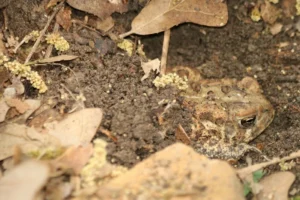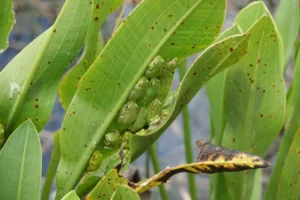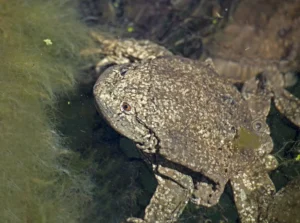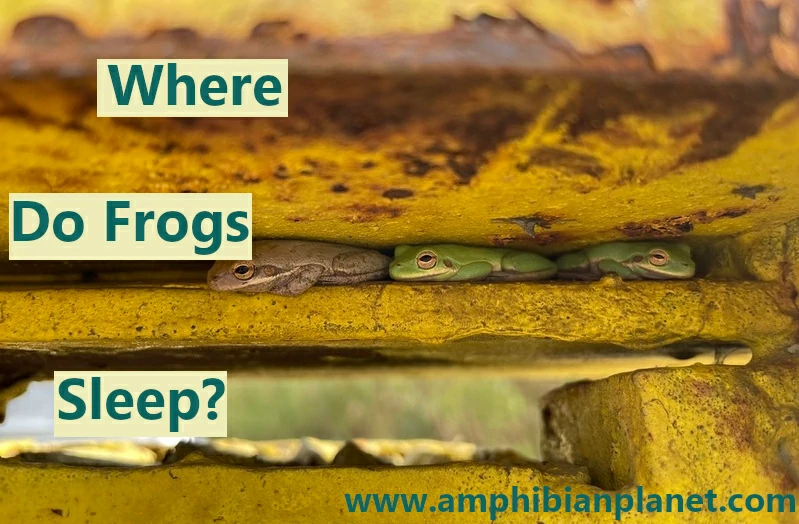There are also many misconceptions about frogs. A few researchers previously reported that some frogs never sleep. However, these ideas have been challenged, and the current scientific consensus is that virtually all animals (including all frogs), show some form of sleep or at least sleep-like states.
In general, terrestrial frogs sleep in leaf litter, rock crevices, logs, underground burrows other cool areas sheltered from direct sunlight. Arboreal frogs sleep on leaves, in tree hollows, bromeliads, and the leaf sheaths of large leaves. Aquatic frogs sleep between rocks, in the roots of aquatic plants, and in other sheltered aquatic locations.
Where frogs sleep is mainly dependent on the type of habitat they are adapted to. Terrestrial frogs can not climb well, and will understandably not sleep in trees, preferring to instead sleep on the ground. Arboreal frogs on the other hand are excellent climbers and can sleep high up in trees.
Aquatic frogs have adaptations for their aquatic lifestyle, and sleep underwater, while submerged without having to resurface to breathe air with their lungs.
Terrestrial Frogs Sleep On Land
Terrestrial frogs are highly adapted for life on land. They spend most of their time in cool areas on the ground that are sheltered from direct sunlight and also offer some form of protection against predators.
Terrestrial frogs will sleep:
- In leaf litter, compost heaps
- Inside hollow logs, cracks in logs
- In caves, rock crevices, and cracks in the foundations of old buildings
- Under rocks, logs, piles of rubble, paving slabs, and other objects
Many terrestrial frogs will also sleep in underground burrows. Since most frogs cannot dig their own burrows, they look for natural holes or abandoned small mammal burrows.
Some burrowing frog and toad species may also dig their own burrows.
Toads are known to dig deep down into loose soil. Many toads have special, hardened knobs on their hind feet that help them dig into the soil. They use their back legs to ‘knead’ their bodies into the soil, burying themselves completely.

How deep they dig can vary from time to time. Some toads can burrow anywhere from 6 inches to over 3 feet deep.
Arboreal Frogs Sleep In Trees And Other Vegetation
Arboreal frogs spend most of their time in and around trees, and their bodies are highly adapted to this lifestyle.
Many tree frogs have small light bodies that allow them to sit on leaves and cling to weak branches without falling. They also have long toes that allow them to wrap around small branches.
Their toes have large, round toe pads that help them cling to branches. These toe pads work like suction cups to help the frog cling to wet leaves and other smooth surfaces. These “sticky toes” mean tree frogs can even cling to glass!
Arboreal frogs will sleep:
- On leaves
- In tree hollows
- In bromeliads
- In the cavities of large flowers
- In the leaf sheaths of large leaves (such as banana leaves), and other cool, hidden locations in the canopy

Aquatic Frogs Sleep Underwater
Aquatic frogs spend most of their time submerged in water, and have several adaptations for this lifestyle. Some aquatic frogs have bodies that are flatter than those of other frogs, giving them a larger skin surface area to absorb oxygen from the water (cutaneous respiration).
Some aquatic frogs have other unique adaptations for their aquatic lifestyle. For example, the Titicaca water frog (Telmatobius culeus) has a wrinkled, excessive amount of skin that makes it look rather as if it were wearing an oversized wet suit.

But this skin performs a very important function– it provides a bigger surface area to use for cutaneous respiration.
For this reason, Titicaca water frogs have greatly reduced lungs – less than one-third the size that would be expected of other frog species of the same body size.
Because of their large skin surface area, these frogs mainly breathe through their skin, and only occasionally use their lungs. In fact, they can stay submerged for several days, breathing only through their skin, without using their lungs.
Aquatic frogs will sleep:
- Between rocks
- In areas sheltered by aquatic vegetation
- Among the roots of aquatic plants
- Under submerged rocks, logs, and in any type of underwater shelter
| Type Of Frog | Where They Sleep |
| Terrestrial frogs | In leaf litter, hollowed-out logs, rock crevices, caves, underground burrows, and other cool, hidden terrestrial locations. |
| Arboreal frogs | In tree hollows, bromeliads, the leaf heaths of large leaves (such as banana leaves), and other cool, hidden locations in the canopy. |
| Aquatic frogs | Between rocks, at the base of aquatic plants, under submerged rocks, logs, and in other sheltered locations. |
What We Know About Sleep In Frogs
Put simply, sleep is a period of reduced activity that is characterized by changes in brain wave activity, breathing, heart rate, body temperature, and other physiological functions.
Two main states are recognized in humans, and other mammals, as well as in birds: slow-wave sleep, also called non-REM sleep, or quiet sleep, and paradoxical sleep, also known as REM sleep or active sleep.
While both quiet sleep and active sleep have clearly been identified in mammals and birds, their presence
in frogs remains highly debated.
In 1982, Ida Gavrilovna Karmanova conducted a study to understand the evolution of sleep in vertebrates –and concluded that amphibians and fish show three forms of rest or sleep-like states (SLS), named ‘protosleep’ or ‘primary sleep’.
- Cataleptic (plastic muscle tone) or protosleep 1
- Catatonic (rigid muscle tone) or protosleep 2
- Cataplectic sleep (atonia)or protosleep 3
Cataleptic sleep appears mainly during the day when the eyes are open, whereas Catatonic and Cataplectic sleep are observed during nighttime rest periods.
The arousal threshold increases relative to the type of protosleep, and the heart rate decreases accordingly.
That said, it’s important to note that not all frogs sleep in the exact same way. In one study, American bullfrogs (Lithobates catesbeianus), were found to remain alert, and able to react to external stimuli, even though immobile and at rest for long periods.
In another study, Squirrel tree frogs (Hyla squirella) and American green tree frogs (Hyla cinerea) in a sleep state were found to only react to moderately intense and direct stimulation (such as shaking the plant they are sleeping on).
Differences in the sleep behavior of different frog species may be because they are adapted to different lifestyles.
How Do Frogs Sleep?
There are over 7,000 described frog and toad species, living in a wide range of habitats from trees to caves to fast-flowing waterbodies. For this reason, the exact sleeping posture, and behavior may vary among different frog species.
That said, there are a few common behaviors that have been observed in several species of frogs when in a sleeping state.
In the earlier mentioned study, the researchers studying the sleep behavior of Squirrel tree frogs and American green tree frogs; observed at least 20 species of each species of frog in a sleeping state.
All of the frogs were:
- Immobile
- Had their eyes closed
- Their limbs tucked under their body
- And their heads pointing downwards, towards the tips of the leaves on which they sat.

After moderately intense and direct stimulation, the frogs ‘awakened’, and asummed a crouching posture, opened their eyes, and sometimes even attempted to escape to a neighbouring plant.
When Do Frogs Seep?
The majority of frog species are primarily either nocturnal or crepuscular and are most active in the dark and twilight hours. However, frogs can sleep at any time of the day.
According to Ida GavrilovnaKarmanova (1982), frogs show Cataleptic sleep mainly during the day and show Catatonic and Cataplectic sleep during nighttime rest periods.
Scientific Research On The Sleep Behavior Of Frogs Is Limited
As mentioned earlier, there are over 7,000 known frog and toad species on the planet. Less than 1% of these species have been studied in the context of sleep.
For this reason, what we currently know about the sleep behavior of frogs is very limited, and may change in the future, with more scientific research.
Some authors previously reported that some frogs, fish, and other animals such as crocodiles never sleep. However, these ideas have been challenged, and the current scientific consensus is that virtually all animals (including all frogs), show some form of sleep or at least sleep-like states.
Sleep enables frogs to conserve, or restore energy, and also performs many other important functions.
Conclusion
Like virtually all animals, frogs show some form of sleep.
Humans and other mammals have 2 sleep states, namely; slow-wave sleep, also called non-REM sleep, or quiet sleep, and paradoxical sleep, also known as REM sleep, or active sleep.
The presence of these sleep states in frogs is not clear and is still highly debated, although some authors suggest quiet sleep (non-REM sleep) may exist in frogs.
Featured image credit: carly_c (CC BY-NC 4.0)
Sources:
Hobson, J. A., Goin, C. J., & Goin, O. B. (1967). Sleep Behavior of Frogs. Quarterly Journal of the Florida Academy of Sciences, 30 (3), 184–186. http://www.jstor.org/stable/24314832
Karmanova, I. G., Evolution of Sleep: Stages of the Formation of the “Wakefulness-Sleep” Cycle in Vertebrates. 1982. Karger, Basel, Originally Published in Russian by Nauka Publishers, Leningrad.
J. Allan Hobson, Electrographic correlates of behavior in the frog with special reference to sleep, Electroencephalography and Clinical Neurophysiology, Volume 22, Issue 2,1967, Pages 113-121, ISSN 0013-4694, https://doi.org/10.1016/0013-4694(67)90150-2.
Libourel PA, Herrel A. Sleep in amphibians and reptiles: a review and a preliminary analysis of evolutionary patterns. Biol Rev Camb Philos Soc. 2016 Aug;91(3):833-66. doi: 10.1111/brv.12197. Epub 2015 May 29. PMID: 26031314.
(2008). Do all animals sleep?. Trends in neurosciences. 31. 208-13. 10.1016/j.tins.2008.02.001.


